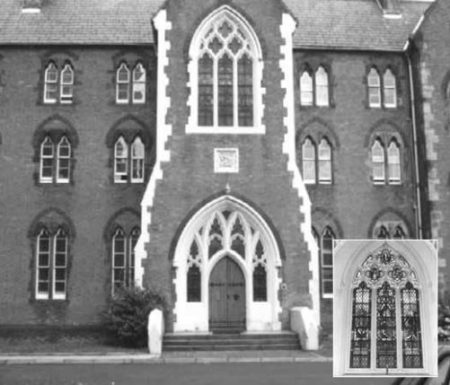Our Trip Down Memory Lane this month brings us to Belfast in the Northern Province. This article was first published in Mercy Live Newspaper in June 2004. Sr. Marie Duddy passed to her heavenly reward in September 2014.
A Founding Story – Sisters Of Mercy Belfast
A century and a half is a long time! By way of introduction to the story of the Sisters of Mercy in Belfast, I shall bring you back on a journey through time, to those momentous few days in early 1854 when the first Sisters of Mercy journeyed from the Motherhouse in Baggot Street, Dublin, to the ‘Black North’, to Co Antrim. Their destination was the town of Belfast and their mission was to bring the charism of Mercy – the care of ‘the Poor, the Sick and the Ignorant’ (to quote the old ‘Holy Rule’) – to those in any kind of need. They would be the first ‘nuns’ to settle in the north-east of Ulster since the reign of Queen Mary (16th century).
Negotiations between Belfast and Dublin about bringing Sisters of Mercy to the Dioceses of Down and Connor had been going on for some years and eventually, towards the end of 1853, more concrete plans began to materialise. By January 1855, final arrangements were completed and the first group of Sisters prepared for their journey north. This was quite an adventure, and shrouded with some secrecy. In a letter to the Bishop, Dr. Cornelius Denvir, Rev. Mother M. Vincent Whitty (Superior, Baggot Street) wrote:
‘I thought it better not to let anyone know of our arrival until the morning of the day we would come to Belfast.’
This cautious note sounds rather shocking in a letter dated one hundred and fifty years ago but even then the ‘Black North’ was a place where Roman Catholic nuns would not be particularly welcome.
The Sisters of Mercy came to Belfast at the request of a group of Catholic businessmen in the town, who saw the urgent need for help for their co-religionists who were flocking into the area during the post-Famine years looking for work. Because of inadequate housing, these poor people were cramped into tiny, unhealthy houses in narrow streets, alleyways, entries and courts where, with the lack of the most basic amenities, there was great poverty and deprivation, much illness and a high mortality rate from diseases and epidemics.
 Belfast City Hall
Belfast City Hall
The first three Sisters – Sisters M. Philomena Maguire, M. Ignatius Crolly and Mary Lister, accompanied by a young monitress named Kate Molloy – arrived in Belfast on Monday 16th January, 1854 and next day were joined by three other Sisters who came from Dublin accompanied by Mother M. Vincent Whitty. These were the pioneers, and they were installed in a large house in Donegall Square North in the very centre of Belfast. This house was facing the White Linen Hall, later rebuilt as Belfast City Hall. Here, they immediately began day schools for children and evening schools for the mill girls and women, and began their visits to the sick and dying and to the prison. A little later they were also asked by the Bishop to take responsibility for a ‘penetentiary’ for women in Bankmore Street, nearby.
On the Feast of Saint Paul, 25th January, the Belfast Mercy foundation was formally established, and on 17th March, Feast of Saint Patrick, Sister M. Philomena Maguire was appointed by the Bishop, Dr. Cornelius Denvir as ‘Mother Superior of the Convent of the Sisters of Mercy in the Town of Belfast’ for six years. Mother M. Philomena was to go on to have an interesting career, making other foundations in Ireland and England and ending her missionary travels in Warrnambool, New South Wales, Australia, where she spent the last years of her life. Her most important other foundation in the Diocese of Down and Connor was in Downpatrick, in June 1855.
 St. Pauls Convent of Mercy, Belfast. Inset: Our Lady’s Oratory, St. Paul’s Belfast
St. Pauls Convent of Mercy, Belfast. Inset: Our Lady’s Oratory, St. Paul’s Belfast
Saint Paul’s Convent
The house in Donegall Square North was understood to be only temporary. From the time that the decision had been taken in Baggot Street to send Sisters to Belfast, negotiations had been going on between Rev. Mother M. Vincent Whitty and Bishop Denvir with regard to building a ‘settled convent’ in the town. When the Sisters were settled in Belfast and their work flourishing, the question of a permanent convent arose again. Diocesan funds could not be spared as the building of churches was a priority in a growing diocese.
However, providence unfailingly stepped in to lend a hand in the form of a very generous bequest in the will of James Duffy by which he left in trust to Bishop Denvir, £1,000 ‘to lay out and disburse’ the building of a suitable house for a female Religious Order which would undertake the ‘moral and religious education of poor female children.’ This bequest was made on 23rd September, 1854 – in fact the eve of the Feast of Our Lady of Mercy!! This will, along with the promise of donations from the wealthier Catholics in Belfast, and the funds from the dowers of the Sisters themselves, made it possible to plan for the building of a ‘settled convent’ which Rev. Mother M. Vincent Whitty required. A site was purchased adjoining the diocesan seminary and the foundation stone of the new convent of Our Lady of Mercy, later to be know as ‘Saint Paul’s’, was laid by Bishop Denvir in May 1855. The Sisters, shortly afterwards, also acquired the land between the new convent site and the Crumlin Road, for the building of schools and an orphanage.
In the autumn of 1857, the new convent on the Crumlin Road was ready for occupation and opened under the patronage of Saint Paul on whose Feast, 25th January 1854, the Sisters had formally taken up residence in Belfast. The Feast has since traditionally been held as ‘Foundation Day’ of the Belfast community. The rest is history.
Marie Duddy is a former archivist in the Northern Province and is currently involved in Interfaith Dialogue in Belfast, Ireland
Marie Duddy rsm
Northern Province


